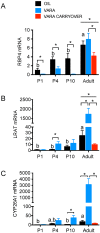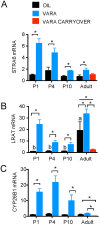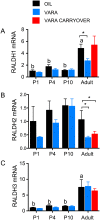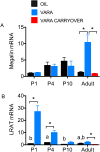Retinoid Homeostatic Gene Expression in Liver, Lung and Kidney: Ontogeny and Response to Vitamin A-Retinoic Acid (VARA) Supplementation from Birth to Adult Age
- PMID: 26731668
- PMCID: PMC4701161
- DOI: 10.1371/journal.pone.0145924
Retinoid Homeostatic Gene Expression in Liver, Lung and Kidney: Ontogeny and Response to Vitamin A-Retinoic Acid (VARA) Supplementation from Birth to Adult Age
Abstract
Vitamin A (VA, retinol) metabolism is homeostatically controlled, but little is known of its regulation in the postnatal period. Here, we determined the postnatal trajectory of VA storage and metabolism in major compartments of VA metabolism-plasma, liver, lung, and kidney from postnatal (P) day 1 to adulthood. We also investigated the response to supplementation with VARA, a combination of VA and 10% all-trans-retinoic acid that previously was shown to synergistically increase retinol uptake and storage in lung. Nursling pups of dams fed a VA-marginal diet received an oral dose of oil (placebo) or VARA on each of four neonatal days: P1, P4, P7, and P10; and again as adults. Tissues were collected 6 h after the final dosing on P1, P4, P10, and at adult age. Gene transcripts for Lrat and Rbp4 in liver and Raldh-1 and Raldh-3 in lung, did not differ in the neonatal period but were higher, P<0.05, in adults, while Cyp26B1, Stra6, megalin, and Raldh-2 in lung did not differ from perinatal to adult ages. VARA supplementation increased total retinol in plasma, liver and lung, with a dose-by-dose accumulation in neonatal liver and lung, while transcripts for Lrat in liver, megalin in kidney, Cyp26A1/B1 in liver and lung, respectively, and Stra6 in lung, were all increased, suggesting pathways of VA uptake, storage and RA oxidation were each augmented after VARA. VARA decreased hepatic expression of Rbp4, responsible for VA trafficking from liver to plasma, and, in lung, of Raldh-1 and Raldh-2, which function in RA production. Our results define retinoid homeostatic gene expression from neonatal and adult age and show that while supplementation with VARA acutely alters retinol content and retinoid homeostatic gene expression in neonatal and adult lung, liver and kidney, VARA supplementation of neonates increased adult-age VA content only in the liver.
Conflict of interest statement
Figures





Similar articles
-
Perinatal exposure to vitamin A differentially regulates chondrocyte growth and the expression of aggrecan and matrix metalloprotein genes in the femur of neonatal rats.J Nutr. 2012 Apr;142(4):649-54. doi: 10.3945/jn.111.152660. Epub 2012 Feb 22. J Nutr. 2012. PMID: 22357747 Free PMC article.
-
Retinol kinetics in unsupplemented and vitamin A-retinoic acid supplemented neonatal rats: a preliminary model.J Lipid Res. 2014 Jun;55(6):1077-86. doi: 10.1194/jlr.M045229. Epub 2014 Apr 7. J Lipid Res. 2014. PMID: 24711633 Free PMC article.
-
Direct and indirect vitamin A supplementation strategies result in different plasma and tissue retinol kinetics in neonatal rats.J Lipid Res. 2016 Aug;57(8):1423-34. doi: 10.1194/jlr.M067165. Epub 2016 Jun 5. J Lipid Res. 2016. PMID: 27264735 Free PMC article.
-
Retinoid production and catabolism: role of diet in regulating retinol esterification and retinoic Acid oxidation.J Nutr. 2003 Jan;133(1):291S-296S. doi: 10.1093/jn/133.1.291S. J Nutr. 2003. PMID: 12514312 Review.
-
Vitamin A kinetics in neonatal rats vs. adult rats: comparisons from model-based compartmental analysis.J Nutr. 2015 Mar;145(3):403-10. doi: 10.3945/jn.114.204065. Epub 2014 Dec 24. J Nutr. 2015. PMID: 25540407 Free PMC article. Review.
Cited by
-
Liver Damage and Exposure to Toxic Concentrations of Endogenous Retinoids in the Pathogenesis of COVID-19 Disease: Hypothesis.Viral Immunol. 2021 Jul-Aug;34(6):376-379. doi: 10.1089/vim.2020.0330. Epub 2021 May 13. Viral Immunol. 2021. PMID: 33983857 Free PMC article.
-
Retinol (Vitamin A) Increases α-Synuclein, β-Amyloid Peptide, Tau Phosphorylation and RAGE Content in Human SH-SY5Y Neuronal Cell Line.Neurochem Res. 2017 Oct;42(10):2788-2797. doi: 10.1007/s11064-017-2292-y. Epub 2017 May 11. Neurochem Res. 2017. PMID: 28497345
-
Retinoic acid promotes tissue vitamin A status and modulates adipose tissue metabolism of neonatal rats exposed to maternal high-fat diet-induced obesity.J Nutr Sci. 2022 Jul 8;11:e54. doi: 10.1017/jns.2022.53. eCollection 2022. J Nutr Sci. 2022. PMID: 35836697 Free PMC article.
-
Postnatal Chick Choroids Exhibit Increased Retinaldehyde Dehydrogenase Activity During Recovery From Form Deprivation Induced Myopia.Invest Ophthalmol Vis Sci. 2016 Sep 1;57(11):4886-4897. doi: 10.1167/iovs.16-19395. Invest Ophthalmol Vis Sci. 2016. PMID: 27654415 Free PMC article.
-
Vitamin A and retinoic acid combined have a more potent effect compared to vitamin A alone on the uptake of retinol into extrahepatic tissues of neonatal rats raised under vitamin A-marginal conditions.Curr Dev Nutr. 2017 Dec 1;1(12):e000265. doi: 10.3945/cdn.116.000265. Epub 2017 Sep 6. Curr Dev Nutr. 2017. PMID: 29377015 Free PMC article.
References
-
- World Health Organization. Guideline for vitamin A supplementation in infants 1–5 months of age. Geneva, Switzerland: World Health Organization,; 2011. Available from: WHO http://www.who.int/nutrition/publications/micronutrients/guidelines/vas_... http://www.ncbi.nlm.nih.gov/books/NBK131993/PDF http://whqlibdoc.who.int/publications/2011/9789241501811_eng.pdf.
-
- World Health Organization. Report: WHO technical consultation on vitamin A in newborn health: mechanistic studies, Geneva, Switzerland, 1–3 December 2009. Geneva: World Health Organization; 2012. iv, 108 p.
-
- Ross AC, Ambalavanan N, Zolfaghari R, Li NQ. Vitamin A combined with retinoic acid increases retinol uptake and lung retinyl ester formation in a synergistic manner in neonatal rats. J Lipid Res. 2006;47(8):1844–51. - PubMed
Publication types
MeSH terms
Substances
Grants and funding
LinkOut - more resources
Full Text Sources
Other Literature Sources
Medical
Miscellaneous

